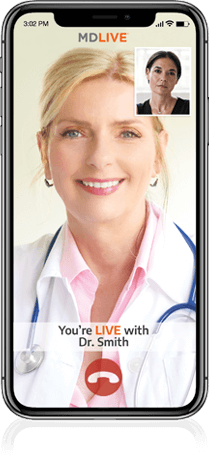If you’ve ever woken up with red, itchy eyes or, worse, crusted over eyelids, you know pink eye can look and feel pretty icky. And it can be especially worrying if you don’t know what’s causing the symptoms. Pink eye, or conjunctivitis, is one of the most common eye infections in children and adults.1
There are four main reasons pink eye symptoms can develop. Conjunctivitis is one of the most common conditions MDLIVE doctors care for, so we asked Dr. Cynthia Collins, MDLIVE Clinical Medical Director, to share her advice on what causes pink eye and how to treat symptoms properly.
- 1https://my.clevelandclinic.org/health/diseases/8614-pink-eye-conjunctivitis#:~:text=Pink%20eye%20is%20one%20of,in%20the%20U.S.%20each%20year
Get the facts on pink eye:
Dr. Collins gives us the facts about how you contract pink eye, common symptoms, and how to treat it. If you develop symptoms, talk to an MDLIVE board-certified doctor in minutes.
Common symptoms of pink eye.
Pink eye can affect one or both eyes. Depending on the cause (most often viruses or bacteria), symptoms can include:
Dr. Collins’ perspective
“From allergies to infections, your eyes can look red, pink, or irritated for many reasons that aren’t always obvious. The good news is that most cases of conjunctivitis don’t require an office visit. They can be reliably diagnosed during a telehealth appointment. Because certain types of pink eye are infectious, you should talk to a doctor when you notice symptoms. Your doctor will help determine the root cause and provide a treatment plan so you can feel better faster.”
Is your pink eye contagious?
Some types of pink eye are highly contagious and can be spread for up to two weeks while symptoms are present.
Viruses
Bacteria
Chemicals or irritants
Allergies (allergic conjunctivitis)
Is it pink eye or allergies?
When your eyes are inflamed, watery, and itchy, it can be hard to tell if it’s an infectious type of pink eye or an allergy, which is an autoimmune reaction and not contagious.3 There are a few slight differences that can help your MDLIVE doctor determine whether the inflammation is contagious or not:
- Viral pink eye – eyes tend to be more watery than crusty.
- Bacterial pink eye – discharge tends to be thick and makes the eyes stick together.
- Allergies – eyes tend to be extremely itchy and watery.
Symptoms can, however, look the same for any type of pink eye, so it’s essential to get treatment early. Allergic conjunctivitis is more common if you already suffer from hay fever. In that case, your doctor may recommend tips like these for easing allergy symptoms.
- 3https://www.health.com/condition/eye-health/pink-eye-or-allergies
How can you get help without going to a doctor’s office?
If your pink eye is contagious, early treatment helps prevent spreading it to others. MDLIVE offers fast, 24/7/365 appointments by phone or video. If you’re having severe symptoms5 or need relief fast, talk to a board-certified doctor who can send a prescription to the pharmacy of your choice. Your MDLIVE doctor can also help determine if something else is causing your pink eye.6
- 5If you have a medical emergency, call 911. If you are experiencing severe eye pain, vision changes, or a severe headache, go to your local ER. Seek immediate medical attention if you experience a life-threatening condition or acute or severe symptoms.
- 6Your MDLIVE doctor can help determine if other causes are present, such as corneal abrasion, herpes in the eye, scleritis, or subconjunctival hemorrhage.
Dr. Collins’ perspective
“Since viral or bacterial conjunctivitis is easily spread, I recommend these hygiene tips for limiting your exposure:
-
Wash your hands often for at least 20 seconds.
-
Don’t touch your eyes or face with your hands.
-
Wash your face every day with a clean washcloth (this can also help prevent allergic conjunctivitis).
-
Don’t share cosmetics, makeup, washcloths, or other personal eye and face care items.
-
Change your pillowcases and sheets often.
-
Wipe away mucus from an infected eye with a fresh, wet cotton ball or pad, and throw that away. Use another clean one for each swipe. Wash your hands afterward.
-
Throw away makeup, cosmetics, or brushes you used while infected.
-
Remove contact lenses immediately and throw them out. Use a new set after your symptoms clear up.
If you or family members develop pink eye symptoms, schedule an appointment with an MDLIVE doctor in minutes to get care fast and learn how to ease symptoms. Returning to work, school, or sports is generally acceptable when eye redness or discharge is no longer present for at least 24 hours.”






